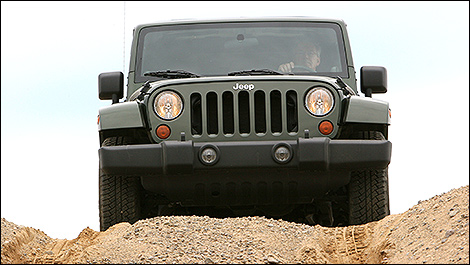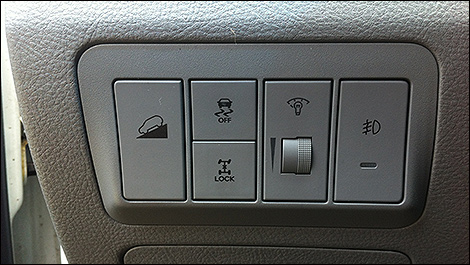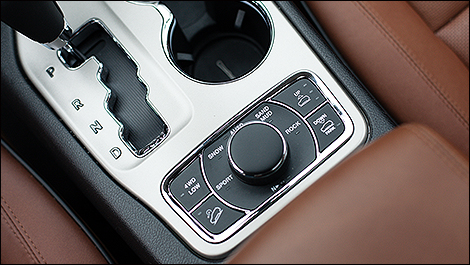Aug
18th
Stay connected Subscribe to our RSS feed
The promise of confidence and peace of mind, on many levels, are key reasons so many Canadians are gravitating towards the ever-expanding sea of crossover SUV models.
Part of that confidence and peace of mind comes from the promise of top-notch traction -- be it for safer navigation of icy roads or more confident trips down the road less travelled. Whatever your need for crossover confidence, enhanced traction is likely part of the appeal.
Many crossover models today go above and beyond in delivering enhanced traction, offering features that turn the dial to 11 on the all-important peace of mind that comes from sure-footed traction. Here's a closer look at some of the unique confidence and traction-enhancing features winding up in more crossover models than ever to try and win over today's crossover shopper.
Four Wheel Drive LOCK
Many crossover models run a computer-controlled, four-wheel or all-wheel drive system that automatically divides engine power between the front and rear wheels based on driving conditions. To save fuel, most of these systems prefer to power just two wheels, most of the time. Some, however, offer a LOCK setting -- typically engaged with a button on the dashboard -- to force the four-wheel drive system into action, locking in an even power split between the front and rear axles whenever it's engaged.
Ideal ahead of tackling extra-slippery terrain, extra-deep snow or before pulling the boat up a steep launch, the LOCK setting is sought out by many shoppers looking for maximum grip at the push of a button. Look for extra traction at the touch of a button via a LOCK setting in models including the Mitsubishi Outlander, Hyundai Santa Fe, Toyota RAV4, Jeep Cherokee, and Nissan Pathfinder.
Downhill Assist
Downhill Assist Control (DAC) or Hill Descent Control (HDC) is marketed with various names by various automakers, but the underlying principle is the same. Going down a steep hill, and especially a steep and slippery hill, can be dangerous. Simply engage the Downhill Assist system fitted to your crossover before heading down the grade, release the pedals, and focus on steering.
Using inclination sensors and advanced, ultra-precise control over the vehicle's throttle, brakes and transmission, the system inches the vehicle carefully and predictably down even the most challenging slopes working the brakes on a wheel-by-wheel basis, if needed. Downhill Assist works to ensure the vehicle goes straight down the hill with minimal drama and at an extremely slow speed, regardless of incline and traction levels. This makes life safer and less stressful in the driver's seat. Look for Downhill Assist systems in models like the Volvo XC60, Jeep Grand Cherokee, Toyota Highlander, Dodge Durango, Acura MDX, Nissan Rogue, and others.
Uphill Assist
Getting up a hill can be tricky business, too -- especially if there's a need to stop and get going again. Not only can this cause wheel-spin that may impede your ability to make it to the top or result in a loss of control, but the effect of a vehicle trying to move forward while it's rolling backwards is very hard on the transmission, too. Solution? Hill Hold Assist or Hill Start Assist.
Like the downhill assist systems, this one is covered by numerous names and one simple concept: When you move your foot from the brake pedal to the throttle after stopping on a hill, the system “freezes” the brake pressure a moment after the brake pedal is released, effectively leaving the brakes on, even if you're not on the pedal. The system releases the brakes only as enough throttle is applied to get the vehicle moving again. The result, from the driver's seat, is largely non-dramatic. The system neutralizes the effects of momentum and gravity, and eliminates rolling backwards, so the vehicle simply starts moving up the hill again without any wheel spin, slipping, digging or loss of control.
In virtually all models, this system engages automatically whenever you're stopped on a hill -- no buttons to press. Look for Hill Start Assist in the Subaru Forester, Honda Pilot, Ford Escape, Lexus RX, Kia Sorento, and many others.
Custom Terrain Management
For serious off-road conditions, numerous crossover models offer an all-terrain dynamics management system, which lets drivers choose from various “modes” that best match current on- or off-road driving conditions. Special modes are typically available for Snow, Sand, Mud, Ruts, Rocks, and more. The all-terrain dynamics management system, marketed with names like Selec-Terrain or Terrain Response, instantly calls up special system calibrations for the throttle, transmission, the AWD or 4x4 system, traction control, and even the differentials to help fully optimize vehicle operation for whatever surface is passing beneath. Throttle response, allowable wheel spin, gear-change logic, and power split between the axles are all fine-tuned for maximum grip on the terrain in question.
With the ability to tell your crossover the type of terrain you're about to tackle, traction can be considerably enhanced. Most of these systems have an AUTO setting too, which is applicable to most normal driving conditions. Look for an all-terrain dynamics management system in the Jeep Cherokee, Jeep Grand Cherokee, Toyota 4Runner, Land Rover LR4, and others.
Torque Vectoring
This fancy-sounding term refers to a simple premise. Torque vectoring basically “shapes” the direction of the vehicle by overpowering one or more wheels in a cornering situation to help steer the vehicle, in addition to actual steering-wheel inputs. Imagine you're in a big boat with someone paddling at each corner, and the two paddlers on the right hand side of the boat are paddling harder and faster. Without using the rudder to steer, the effect of more propulsion on one side of the boat will tend to point it in the opposite direction. So, in an all-wheel drive crossover, like a Nissan Juke or Subaru Forester, torque vectoring works similarly, but with wheels not paddles. More power is sent to the outer wheels in a cornering situation, helping point the vehicle into the corner. This doesn't create more traction it simply makes better use of the traction available, and enhances handling and control in all conditions as a result.
Part of that confidence and peace of mind comes from the promise of top-notch traction -- be it for safer navigation of icy roads or more confident trips down the road less travelled. Whatever your need for crossover confidence, enhanced traction is likely part of the appeal.
Many crossover models today go above and beyond in delivering enhanced traction, offering features that turn the dial to 11 on the all-important peace of mind that comes from sure-footed traction. Here's a closer look at some of the unique confidence and traction-enhancing features winding up in more crossover models than ever to try and win over today's crossover shopper.
 |
| Photo: Philippe Champoux |
Four Wheel Drive LOCK
Many crossover models run a computer-controlled, four-wheel or all-wheel drive system that automatically divides engine power between the front and rear wheels based on driving conditions. To save fuel, most of these systems prefer to power just two wheels, most of the time. Some, however, offer a LOCK setting -- typically engaged with a button on the dashboard -- to force the four-wheel drive system into action, locking in an even power split between the front and rear axles whenever it's engaged.
Ideal ahead of tackling extra-slippery terrain, extra-deep snow or before pulling the boat up a steep launch, the LOCK setting is sought out by many shoppers looking for maximum grip at the push of a button. Look for extra traction at the touch of a button via a LOCK setting in models including the Mitsubishi Outlander, Hyundai Santa Fe, Toyota RAV4, Jeep Cherokee, and Nissan Pathfinder.
Downhill Assist
Downhill Assist Control (DAC) or Hill Descent Control (HDC) is marketed with various names by various automakers, but the underlying principle is the same. Going down a steep hill, and especially a steep and slippery hill, can be dangerous. Simply engage the Downhill Assist system fitted to your crossover before heading down the grade, release the pedals, and focus on steering.
Using inclination sensors and advanced, ultra-precise control over the vehicle's throttle, brakes and transmission, the system inches the vehicle carefully and predictably down even the most challenging slopes working the brakes on a wheel-by-wheel basis, if needed. Downhill Assist works to ensure the vehicle goes straight down the hill with minimal drama and at an extremely slow speed, regardless of incline and traction levels. This makes life safer and less stressful in the driver's seat. Look for Downhill Assist systems in models like the Volvo XC60, Jeep Grand Cherokee, Toyota Highlander, Dodge Durango, Acura MDX, Nissan Rogue, and others.
 |
| Photo: Mathieu Germain |
Uphill Assist
Getting up a hill can be tricky business, too -- especially if there's a need to stop and get going again. Not only can this cause wheel-spin that may impede your ability to make it to the top or result in a loss of control, but the effect of a vehicle trying to move forward while it's rolling backwards is very hard on the transmission, too. Solution? Hill Hold Assist or Hill Start Assist.
Like the downhill assist systems, this one is covered by numerous names and one simple concept: When you move your foot from the brake pedal to the throttle after stopping on a hill, the system “freezes” the brake pressure a moment after the brake pedal is released, effectively leaving the brakes on, even if you're not on the pedal. The system releases the brakes only as enough throttle is applied to get the vehicle moving again. The result, from the driver's seat, is largely non-dramatic. The system neutralizes the effects of momentum and gravity, and eliminates rolling backwards, so the vehicle simply starts moving up the hill again without any wheel spin, slipping, digging or loss of control.
In virtually all models, this system engages automatically whenever you're stopped on a hill -- no buttons to press. Look for Hill Start Assist in the Subaru Forester, Honda Pilot, Ford Escape, Lexus RX, Kia Sorento, and many others.
Custom Terrain Management
For serious off-road conditions, numerous crossover models offer an all-terrain dynamics management system, which lets drivers choose from various “modes” that best match current on- or off-road driving conditions. Special modes are typically available for Snow, Sand, Mud, Ruts, Rocks, and more. The all-terrain dynamics management system, marketed with names like Selec-Terrain or Terrain Response, instantly calls up special system calibrations for the throttle, transmission, the AWD or 4x4 system, traction control, and even the differentials to help fully optimize vehicle operation for whatever surface is passing beneath. Throttle response, allowable wheel spin, gear-change logic, and power split between the axles are all fine-tuned for maximum grip on the terrain in question.
With the ability to tell your crossover the type of terrain you're about to tackle, traction can be considerably enhanced. Most of these systems have an AUTO setting too, which is applicable to most normal driving conditions. Look for an all-terrain dynamics management system in the Jeep Cherokee, Jeep Grand Cherokee, Toyota 4Runner, Land Rover LR4, and others.
 |
| Photo: Sébastien D'Amour |
Torque Vectoring
This fancy-sounding term refers to a simple premise. Torque vectoring basically “shapes” the direction of the vehicle by overpowering one or more wheels in a cornering situation to help steer the vehicle, in addition to actual steering-wheel inputs. Imagine you're in a big boat with someone paddling at each corner, and the two paddlers on the right hand side of the boat are paddling harder and faster. Without using the rudder to steer, the effect of more propulsion on one side of the boat will tend to point it in the opposite direction. So, in an all-wheel drive crossover, like a Nissan Juke or Subaru Forester, torque vectoring works similarly, but with wheels not paddles. More power is sent to the outer wheels in a cornering situation, helping point the vehicle into the corner. This doesn't create more traction it simply makes better use of the traction available, and enhances handling and control in all conditions as a result.
 The latest auto news, reviews, prices, product and vehicle releases.
The latest auto news, reviews, prices, product and vehicle releases.